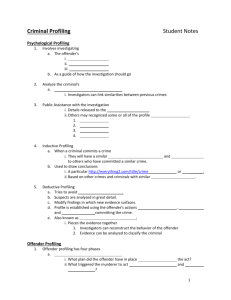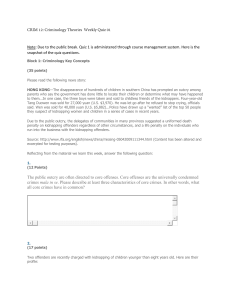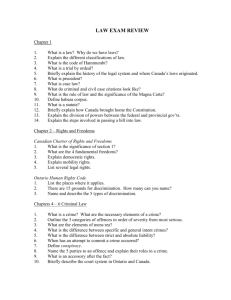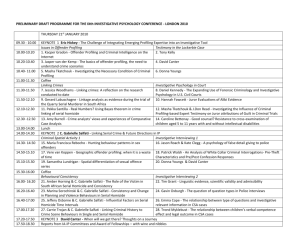Academy of Behavioral Profiling
advertisement
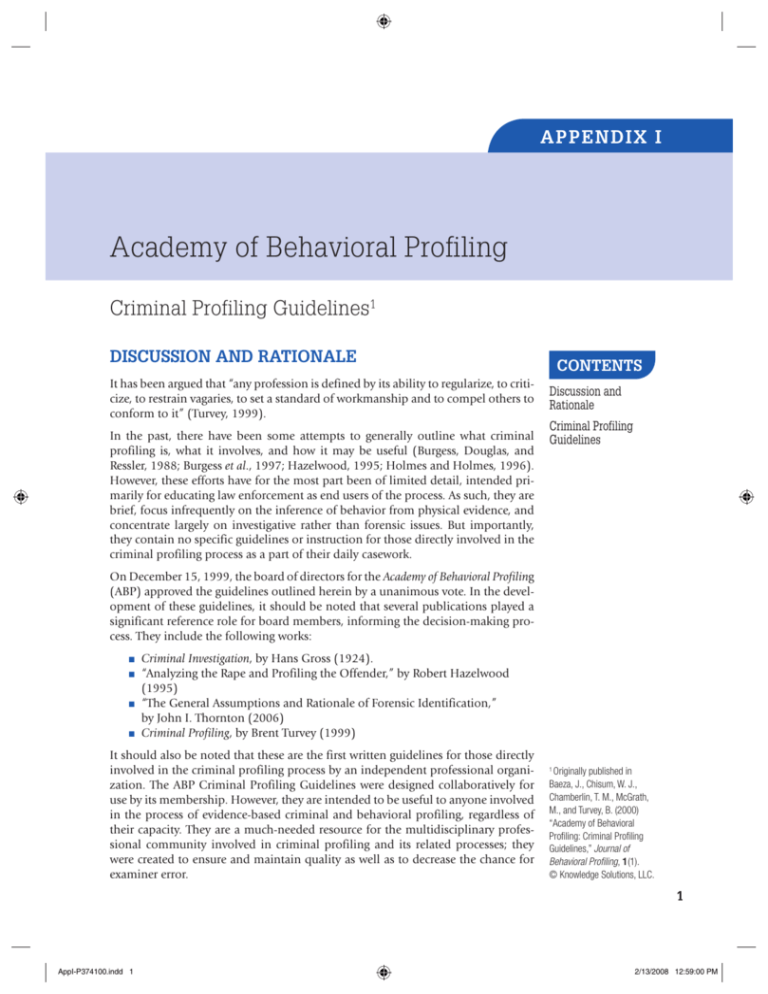
APP ENDIX I Academy of Behavioral Profiling Criminal Profiling Guidelines1 DISCUSSION AND RATIONALE It has been argued that “any profession is defined by its ability to regularize, to criticize, to restrain vagaries, to set a standard of workmanship and to compel others to conform to it” (Turvey, 1999). In the past, there have been some attempts to generally outline what criminal profiling is, what it involves, and how it may be useful (Burgess, Douglas, and Ressler, 1988; Burgess et al., 1997; Hazelwood, 1995; Holmes and Holmes, 1996). However, these efforts have for the most part been of limited detail, intended primarily for educating law enforcement as end users of the process. As such, they are brief, focus infrequently on the inference of behavior from physical evidence, and concentrate largely on investigative rather than forensic issues. But importantly, they contain no specific guidelines or instruction for those directly involved in the criminal profiling process as a part of their daily casework. CONTENTS Discussion and Rationale Criminal Profiling Guidelines On December 15, 1999, the board of directors for the Academy of Behavioral Profiling (ABP) approved the guidelines outlined herein by a unanimous vote. In the development of these guidelines, it should be noted that several publications played a significant reference role for board members, informing the decision-making process. They include the following works: ■ ■ ■ ■ Criminal Investigation, by Hans Gross (1924). “Analyzing the Rape and Profiling the Offender,” by Robert Hazelwood (1995) “The General Assumptions and Rationale of Forensic Identification,” by John I. Thornton (2006) Criminal Profiling, by Brent Turvey (1999) It should also be noted that these are the first written guidelines for those directly involved in the criminal profiling process by an independent professional organization. The ABP Criminal Profiling Guidelines were designed collaboratively for use by its membership. However, they are intended to be useful to anyone involved in the process of evidence-based criminal and behavioral profiling, regardless of their capacity. They are a much-needed resource for the multidisciplinary professional community involved in criminal profiling and its related processes; they were created to ensure and maintain quality as well as to decrease the chance for examiner error. 1 Originally published in Baeza, J., Chisum, W. J., Chamberlin, T. M., McGrath, M., and Turvey, B. (2000) “Academy of Behavioral Profiling: Criminal Profiling Guidelines,” Journal of Behavioral Profiling, 1(1). © Knowledge Solutions, LLC. 1 AppI-P374100.indd 1 2/13/2008 12:59:00 PM 2 APPENDIX I Academy of Behavioral Profiling They were disseminated to the ABP membership along with the following quotation (Thornton, 2006): Forensic science cannot be viewed solely in terms of its products; it is also judged by the legitimacy of the processes by which evidence is examined and interpreted. Any opinion rendered by a forensic scientist in a written report or in court testimony must have a basis in fact and theory. Without such a basis, any conclusions reached are bereft of validity and should be treated with derision. This passage expresses a significant part of the doctrine that was considered in the design of these guidelines and the philosophy they are intended to engender. More than simply a checklist, these guidelines impart a professional forensic philosophy of case examination that is logical, informed, and thorough. They also presuppose a measure of examiner enthusiasm for objectivity and attention to detail. At their core is the ideal, expressed by Peter Novick in his work on professionalization, That Noble Dream (Novick, 1988), that the value of any interpretation should be judged by how well it accounts for the facts; if contradicted by the facts, it should be abandoned. In as much as all of these things are true, the development of these guidelines is a necessary step in the direction of professionalization, helping to provide a sturdy platform for caseworkers in this field to stand on. CRIMINAL PROFILING GUIDELINES Notes In all casework where examiners participate as investigative support, crime analysts, or criminal profilers, examiners are expected to keep and maintain reasonably detailed notes documenting their examination of case materials. Written Reports Investigative Support In all casework where examiners participate as investigative support, examiners are expected to make written reports of their findings in the form of a threshold assessment, a crime analysis, or a criminal profile as appropriate. It is understood that these are investigative documents only and do not necessarily represent expert findings. Expert Examination for Trial In all casework where examiners expect to present expert findings before the court, it is preferable that the examiner should make written reports of their findings in the form of a crime analysis or a criminal profile as appropriate. It is understood that the client or agency retaining the examiner reserves the right to request a report, which includes only those conclusions that may be the focus of testimony, or decline a written conclusions entirely. It is further understood that this should in no way effect the examiner’s overall methods of examination, conclusions, or notes. Depositions and Testimony In all casework where examiners present expert findings to the court, it is understood that they will testify in a clear and consistent fashion. It is also understood AppI-P374100.indd 2 2/13/2008 12:59:01 PM Objectivity and Bias 3 that examiners will not offer opinions on matters outside of their areas of knowledge or expertise, as well as follow the other ethical guidelines of the ABP. It is further understood that any opinions given by the examiner will be predicated on evidence from the case at hand and that the sources of that evidence will be made clear to the court upon request. OBJECTIVITY AND BIAS In all casework where examiners participate as investigative support, crime analysts, or criminal profilers, examiners are expected to maintain an attitude of objectivity and guard against bias, personal or otherwise. It is understood that bias may not be removed completely from the examination process but that efforts can be made to minimize its effects. Guidelines To guard against bias and maintain an attitude of objectivity, examiners should do the following: ■ ■ ■ ■ Strive to avoid, when feasible, suspect information when rendering a threshold assessment or criminal profile. Strive to avoid preconceived theories of the crime. Not conceal or ignore evidence that detracts from or falsifies a particular theory of the crime. Seek out the advice of colleagues as needed. Threshold Assessment A threshold assessment is an investigative report that reviews the initial physical evidence of crime-related behavior, victimology, and crime scene characteristics for a particular unsolved crime or a series of potentially related unsolved crimes in order to provide immediate investigative direction. It should include what is generally known of events, what is not, and suggestions regarding any means by which the former may be established. It is not to be confused with, or presented as, a criminal profile. Guidelines A threshold assessment should include the following elements: ■ ■ ■ ■ ■ ■ AppI-P374100.indd 3 Overview of the established facts of the case relevant to crime-related behavior as appropriate Overview of the established facts of the case relevant to victimology as appropriate Overview of the established facts of the case relevant to crime scene characteristics as appropriate, with supporting argumentation Initial hypothesis regarding potential motivational behaviors and aspects, as appropriate, with supporting argumentation Initial hypothesis regarding potential offender characteristics, as appropriate, with supporting argumentation Suggestions regarding further facts that need to be determined or established to address logical breaks in the sequence of events surrounding the crime, including suggestions regarding additional forensic analyses that may be performed on available physical evidence 2/13/2008 12:59:01 PM 4 APPENDIX I Academy of Behavioral Profiling ■ ■ Suggestions regarding further victimological information gathering Investigatively relevant suggestions regarding potential strategies or avenues for suspect development Victimology Victimology is a thorough study of all available victim information. This includes items such as sex, age, height, weight, family, friends, acquaintances, education, employment, residence, and neighborhood. This also includes background information on the history and lifestyle of the victim such as overall personal habits, hobbies, criminal history, and medical histories. Establishing victimology is a necessary part of determining the context of some crimes. It is understood that some of the elements of a crime analysis or a criminal profile may depend on this information. The purpose of establishing the victimology in a particular case is to enable the examiner to make an informed assessment of that victim’s risk of becoming a victim of a particular type of crime in regard to the victim’s lifestyle, overall as well as during the events preceding the victim’s demise. It may also facilitate case linkage assessments. Crime Analysis A crime analysis is a report that examines and interprets the behavioral evidence for a particular crime or a series of related crimes. It is understood that a crime analysis should be based on victim behaviors, offender behaviors, and environmental circumstances that are directly observed by the examiner, logically inferred from the case documentation, or reconstructed by the appropriate forensic specialists. Crime-related behaviors and circumstances should not be assumed for the purpose of performing the crime analysis. Appropriate references should be made to the established case facts to support the examiner’s interpretations. Guidelines A crime analysis should include the following elements, with references when appropriate: ■ ■ ■ ■ ■ ■ Overview of the established facts of the case relevant to crime related behavior Overview of the established facts of the case relevant to victimology An opinion as to the lifestyle risk of each victim when possible, with supporting argumentation An opinion as to the situational risk of each victim, when possible, with supporting argumentation An opinion as to the risk taken by the offender to acquire each victim, when possible, with supporting argumentation An analysis of the scene characteristics for each crime, when possible, with supporting argumentation, to include consideration of the following, at the minimum: Location and scene types Point of contact Offender method of approach AppI-P374100.indd 4 2/13/2008 12:59:01 PM Objectivity and Bias 5 Offender method of attack Offender methods of control Offender use of weapons Offender use of force Victim resistance Sexual acts Precautionary acts Contradictory acts Evidence of planning Offense skill level Items taken by the offender Items left behind by the offender Verbal behavior Modus operandi behavior Motivational behavior ■ Opinions as to the motivation evidenced by the crime-related behavior, when possible, with supporting argumentation Criminal Profile A criminal profile is a report that describes the investigatively relevant or probative characteristics of the offender responsible for a particular crime or a series of related crimes based on a thorough crime analysis. It should include the crime analysis and victimological information as a foundation, as well as logical, evidence-based arguments for each offender characteristic elicited from that foundation. It is understood that the criminal profile is actually comprised of any offender characteristics elicited from the crime analysis or victimology. It is subsequently understood that a criminal profile cannot be rendered without first performing a crime analysis or victimology. Offender Characteristics Offender characteristics include any attributes that the examiner ascribes specifically to the unknown person or persons responsible for the commission of particular criminal acts, including those that are physical, psychological, social, geographical, or relational. They can also include predictions about likely offender behavior before, during, or after a crime. One type of physical attribute is offender height. One type of psychological attribute is an offender’s state of mind before, during, or after the crime. One type of geographical attribute is where an offender lives. One type of social attribute is the type of relationship partner the offender prefers. One type of relational attribute is the nature of an offender’s relationship with the victim. One type of prediction about likely offender behavior is whether or not the offender will return to a crime scene. Guidelines A criminal profile should include the following elements, with references when appropriate: ■ ■ AppI-P374100.indd 5 Overview of the established facts of the case relevant to crime-related behavior Overview of the established facts of the case relevant to victimology 2/13/2008 12:59:01 PM 6 APPENDIX I Academy of Behavioral Profiling ■ ■ ■ ■ An opinion as to the lifestyle risk of each victim, when possible, with supporting argumentation An opinion as to the situational risk of each victim, when possible, with supporting argumentation An opinion as to the risk taken by the offender to acquire each victim, when possible, with supporting argumentation An analysis of the scene characteristics for each crime, when possible, with supporting argumentation, to include consideration of the following, at the minimum: Location and scene types Point of contact Offender method of approach Offender method of attack Offender methods of control Offender use of weapons Offender use of force Victim resistance Sexual acts Precautionary acts Contradictory acts Evidence of planning Offense skill level Items taken by the offender Items left behind by the offender Verbal behavior Modus operandi behavior Motivational behavior ■ ■ Opinions as to the motivation evidenced by the crime-related behavior, when possible, with supporting argumentation. Opinions as to investigatively relevant or probative offender characteristics, when possible, with supporting argumentation; these can include, but are by no means limited to, characteristics such as the following: Knowledge of/familiarity with victim Knowledge of/familiarity with location Evidence of criminal history Evidence relating to state of mind Evidence of psychopathic characteristics such as superficiality, deceitfulness, impulsively, lack of empathy, lack of remorse, egocentricity, or a need for excitement Evidence of personal or sexual conflict Evidence of sexual fantasy REFERENCES Burgess, A., Burgess, A., Douglas, J., and Ressler, R. (1997) Crime Classification Manual, San Francisco: Jossey-Bass. Burgess A., Douglas J., and Ressler R. (1988) Sexual Homicide: Patterns and Motives, New York: Lexington Books. AppI-P374100.indd 6 2/13/2008 12:59:01 PM References 7 Gross, H. (1924) Criminal Investigation, London: Sweet & Maxwell. Hazelwood, R. (1995) “Analyzing the Rape and Profiling the Offender,” in Burgess, A., and Hazelwood, R. (Eds.), Practical Aspects of Rape Investigation, 2nd ed., New York: CRC Press. Holmes R., and Holmes S. (1996) Profiling Violent Crimes: An Investigative Tool, 2nd ed., Thousand Oaks, CA: Sage. Novick, P. (1988) That Noble Dream: The Objectivity Question and the American Historical Profession, New York: Cambridge University Press. Thornton, John I., (2006) “The General Assumptions and Rationale of Forensic Identification,” in Faigman, D., Kaye, D., Saks, M., and Sanders, J. (Eds.), Modern Scientific Evidence: The Law and Science of Expert Testimony, vol. 2, St. Paul, MN: West. Turvey, B. (1999) Criminal Profiling: An Introduction to Behavioral Evidence Analysis, London: Academic Press. AppI-P374100.indd 7 2/13/2008 12:59:01 PM AppI-P374100.indd 8 2/13/2008 12:59:01 PM
